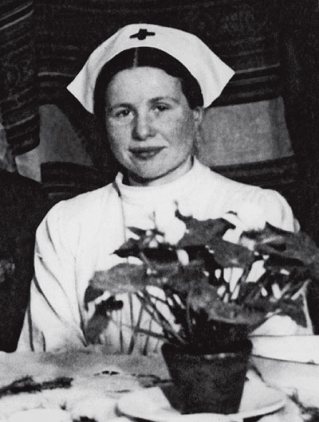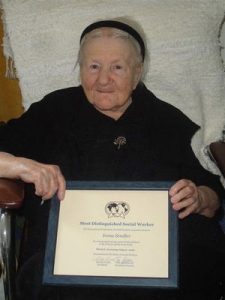Irena Sendler
“When war started, all of Poland was drowning in a sea of blood. But most of all, it affected the Jewish nation. And within that nation, it was the children who suffered most. That’s why we needed to give our hearts to them.”
Irena Sendlerowa (Sendler)
In 1999, a Kansas schoolteacher gave four students a project for National History Day. Handing them a 1994 news clipping, which stated: “Irena Sendler saved 2,500 children from Warsaw Ghetto in 1942 – 3”, he asked them to research the person and the story for its accuracy. He thought perhaps there’d been a typing error in the numbers quoted as he was unfamiliar with the lady or the events. The girls uncovered an amazing story of courage and compassion which has continued to reverberate way beyond the completion of the project
Irena was born in 1910 in a small town southeast of Warsaw. Her physician father, Stanislaw Krzyanowski, instilled within her a deep empathy for the Jewish people and a love of everybody, no matter what their social standing or creed was. “If you see someone drowning,” he told her, “you must jump in and save them, even if you don’t know how to swim.” Dr Krzyanowski was among the first Socialists in Poland and one of only a handful of Catholic doctors who ministered to destitute Jews. He died in 1917 after contracting typhus while treating them.
In the 1930s, Irena openly opposed the segregation of Jews at Warsaw University where she was studying. Her protest earned her a three year ban at the University. By 1939, she was Senior Administrator in the Social Welfare Department in Warsaw and was helping to feed, clothe and give financial aid to the city’s poor and needy, of whom a large proportion were Jews. When the Germans invaded Poland late that year, it was necessary for Irena and her workers to go to great lengths to protect these vulnerable people.
They arranged for some Jews to escape through fake documentation, while others were registered under false names. By claiming that tuberculosis and typhoid had broken out, they succeeded in avoiding close scrutiny. By 1942, the Warsaw Ghetto was established which was a huge compound, housing thousands of Jews behind its massive walls, on top of which was placed broken glass, the ultimate escape deterrent. 
Disease now became rife and along with starvation and malnutrition, around 5,000 people were dying each month. Through Irena’s contacts within the Social Welfare Department, she obtained the necessary pass to enable her to enter the Ghetto and treat the sick and dying with medicines and food.
For Irena though, this wasn’t enough. She was sickened by the conditions in which these families lived and joined the newly formed Polish underground organisation Zegota, the Council for Aid to Jews and made it her mission to rescue as many Jewish children as she was able. By this time, the Nazis had begun deporting the Polish Jews to a concentration camp in the north east of the country and this only strengthened Irena’s resolve.
Together with a small group of social workers, Irena – going under the code name ‘Jolanta’ - organised safe houses and escape routes, before beginning the enormous task of trying to persuade parents to part with their children. In later years, she said that when parents asked her if she could guarantee they would live, she answered only that she could guarantee they would die if they stayed. She added, “In my dreams, I still hear the cries when they left their parents.”
At great risk, children were smuggled out in sacks, body bags, suitcases and cardboard boxes. While some were hidden in coffins and ambulances, others were placed among goods or rubbish, even a mechanic’s tool box was used to carry one baby out. The underground sewage system proved an effective escape route as was the old courthouse. This building had two entrances, one on the Ghetto side and the other on the “Aryan” side of the city. Children taken in from the Ghetto found safety through the other door.
Those who provided sanctuary for the youngsters also risked their lives with the threat of the death penalty if caught and around 700 people died this way. Though no one, according to Irena, ever refused to take in a child, sometimes for security reasons it was necessary to move them several times. She recalled one distressed little boy asking her “how many mums can you have, for this is the third one I’m going to!” 
As well as private homes, orphanages and convents also took children in. Bundles of second hand clothes donated to these institutions often contained a child hidden inside.
Although false documents were arranged for each child, Irena was determined that their original identities would never be lost. She wrote their real names on pieces of paper along with their ‘adopted’ names and placed them in sealed jam jars which she then buried in a friend’s garden. She hoped that at the end of the war, if at all possible, to reunite children with their families – at the very least they had a right to know of their origins.
Word eventually reached the Gestapo of Irena’s activities and on the 20th of October 1943 she was arrested and taken to Pawiak Prison, where she was tortured. Despite being severely injured, she refused to talk and so was sentenced to death. However, before the execution could take place, she was rescued by Zegota colleagues who bribed a Gestapo officer to free her. Zegota then took her into hiding where she spent the remainder of the war working just as hard for the cause, behind the scenes.
At the end of the war Irena retrieved the jars and set out to trace the 2,500 children whose names she’d carefully recorded and attempted to reunite them with their families. Unfortunately, many relatives either could not be traced or had ended up in the death camps. Where possible, children were returned to relatives, though some chose to remain with their ‘adopted’ families.
Poland’s post-war Communist government looked on Irena as a subversive, closely monitoring her activities. Nevertheless she continued to work in Social Welfare helping the needy whether young or old.
In 1965 she received the first of the awards to honour her work, the Yad Vashim Medal as one of the Righteous Among the Nations. She was recognised by Israel in 1983 with the Commander’s Cross but it was to be after the millenium before before the awards came thick and fast. In 2003 she received Poland’s highest civilian decoration, the Order of the White Eagle and also that year the Jan Karski Award of Valour and Courage from the USA. 
The Order of the Smile came in 2007, given to adults for their love, care and aid to children. That year saw her being honoured by Poland’s Senate as well as being nominated for the Nobel Peace Prize, which incidentally went to former US Vice President Al Gore for his involvement on the Intergovernmental Panel on climate change. A year after her death, May 2009 she was posthumously granted the Audrey Hepburn Humanatarian Award, acknowledging her work in helping children.
Often, after her photograph appeared in a newspaper, Irena would receive a telephone call from someone who would say, “I remember your face! You took me out of the Ghetto!” They may have known her as Jolanta but they instantly recognised their rescuer.
But for Irena there was nothing heroic about what she did. “Every child saved with my help,” she wrote in a letter to the Polish Parliament, “is the justification of my life on this earth, and not a title to glory.” She always felt she could have done more, a regret she once said would “follow me to my death.”
Irena Sendler died on the 12th of May 2008 but she certainly won’t be forgotten. Those four Kansas students won the National History Day competition with a play they wrote on Irena’s life called “Life in a Jar”, which they’ve performed in churches, clubs and community halls throughout the USA, Canada and Europe. Other students have also got involved and almost 300 performances will have been held by the end of 2011. They are determined to keep spreading Irena’s story to as many people as possible.
In 2007 Irena was interviewed by ABC News and despite her 97 years, it was obvious she had lost none of the spirit that had sustained her throughout the wartime years. “After the Second World War it seemed that humanity understood something and that nothing like that would happen again. Humanity has understood nothing. Religious, tribal, national wars continue. The world continues to be in a sea of blood. But… the world can be better, if there’s love, tolerance and humility.”


 Entries(RSS)
Entries(RSS)